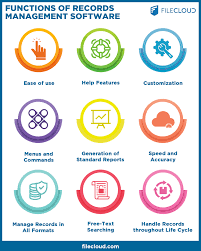
The Benefits of an Automated Records Management System
In today’s digital age, the volume of data generated by organizations is growing exponentially. Managing and organizing this vast amount of information can be a daunting task, especially when it comes to records management. This is where automated records management systems come into play, offering a range of benefits for businesses of all sizes.
Efficiency and Time Savings
One of the primary advantages of an automated records management system is the significant improvement in efficiency and time savings. By automating the process of capturing, storing, and retrieving records, organizations can streamline their operations and reduce the time spent on manual tasks. This allows employees to focus on more strategic activities that drive business growth.
Improved Accuracy and Compliance
Automated records management systems help ensure data accuracy and compliance with regulatory requirements. By implementing predefined rules and workflows, organizations can maintain consistency in record-keeping practices and reduce the risk of errors or omissions. This not only enhances data integrity but also helps businesses meet legal obligations and industry standards.
Enhanced Security and Access Control
Security is a top priority for organizations when it comes to managing sensitive information. Automated records management systems offer robust security features such as encryption, access controls, audit trails, and disaster recovery capabilities. These measures help protect data from unauthorized access, breaches, or loss, ensuring that confidential information remains secure at all times.
Cost Savings
Implementing an automated records management system can lead to cost savings in the long run. By reducing manual labor, paper usage, storage space requirements, and potential compliance fines, organizations can achieve greater operational efficiency and financial benefits. Additionally, automation helps optimize resource allocation and minimize overhead costs associated with traditional record-keeping methods.
Scalability and Flexibility
An automated records management system provides scalability and flexibility to adapt to changing business needs. Whether an organization experiences growth or restructuring, the system can easily accommodate new requirements without disrupting existing processes. This agility enables businesses to stay agile in a dynamic marketplace and respond quickly to evolving record management demands.
Conclusion
Overall, an automated records management system offers numerous advantages that empower organizations to effectively manage their information assets in a digital environment. From increased efficiency and accuracy to enhanced security and cost savings, the benefits are clear for businesses looking to optimize their record-keeping practices. By embracing automation technology, organizations can gain a competitive edge while ensuring compliance with regulatory standards and safeguarding sensitive data.
5 Key Strategies for Optimizing Your Automated Records Management System
- Define clear policies and procedures for the automated records management system.
- Regularly train employees on how to use the system effectively.
- Ensure data security measures are in place to protect sensitive information.
- Regularly audit and monitor the system to ensure compliance with regulations.
- Implement a proper backup and disaster recovery plan for the records stored in the system.
Define clear policies and procedures for the automated records management system.
To ensure the effective implementation of an automated records management system, it is crucial to define clear policies and procedures that govern its usage. Establishing comprehensive guidelines helps streamline operations, enhance data consistency, and promote compliance with regulatory requirements. By outlining specific rules for record capture, storage, access control, retention periods, and disposal processes, organizations can mitigate risks and maintain the integrity of their information assets. Clear policies and procedures also facilitate user training, accountability, and auditability, fostering a culture of responsible data management within the organization.
Regularly train employees on how to use the system effectively.
To maximize the benefits of an automated records management system, it is crucial to regularly train employees on how to use the system effectively. By providing ongoing training sessions and resources, organizations can ensure that employees are proficient in utilizing the system’s features and functionalities. This not only enhances productivity and efficiency but also minimizes errors and promotes a culture of compliance with record-keeping practices. Investing in employee training demonstrates a commitment to leveraging technology for improved information management and empowers staff to make the most of the automated records management system in their daily workflows.
Ensure data security measures are in place to protect sensitive information.
When implementing an automated records management system, it is crucial to prioritize data security measures to safeguard sensitive information effectively. By incorporating encryption, access controls, regular audits, and disaster recovery protocols, organizations can mitigate the risk of unauthorized access, breaches, or data loss. Ensuring robust security measures not only protects confidential data but also instills trust among stakeholders and demonstrates a commitment to maintaining the integrity and confidentiality of information assets.
Regularly audit and monitor the system to ensure compliance with regulations.
Regularly auditing and monitoring an automated records management system is crucial to ensuring compliance with regulations and maintaining data integrity. By conducting routine assessments of the system’s processes, access controls, and security measures, organizations can identify any potential gaps or issues that may impact regulatory compliance. Monitoring activities also help in detecting unauthorized access attempts, unusual behavior, or data breaches promptly. By staying vigilant and proactive in auditing the system, businesses can uphold regulatory standards, mitigate risks, and demonstrate a commitment to safeguarding sensitive information effectively.
Implement a proper backup and disaster recovery plan for the records stored in the system.
When implementing an automated records management system, it is crucial to prioritize the establishment of a robust backup and disaster recovery plan for the records stored within the system. By ensuring that proper backup procedures are in place, organizations can safeguard their data against unforeseen events such as system failures, cyber attacks, or natural disasters. A comprehensive disaster recovery plan not only helps mitigate potential data loss but also enables quick restoration of critical information in times of crisis, maintaining business continuity and minimizing downtime. Investing in backup and disaster recovery measures is essential for protecting the integrity and accessibility of records within an automated management system, providing peace of mind and resilience against unexpected disruptions.
